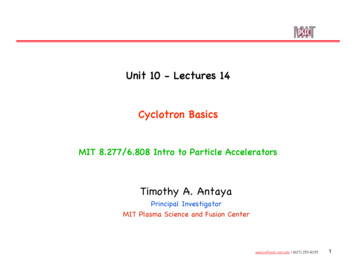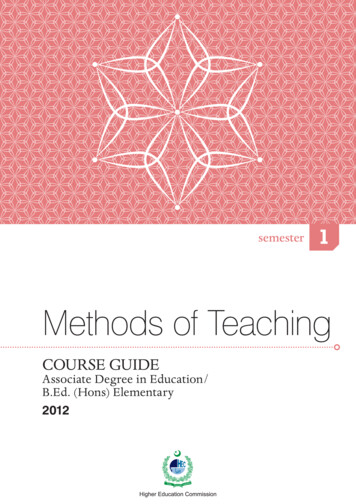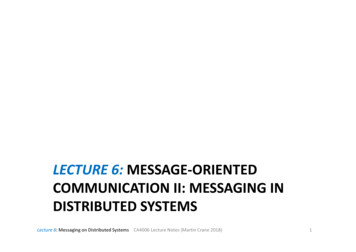
Transcription
Unit 10 - Lectures 14Cyclotron BasicsMIT 8.277/6.808 Intro to Particle AcceleratorsTimothy A. AntayaPrincipal InvestigatorMIT Plasma Science and Fusion Centerantaya@psfc.mit.edu / (617) 253-81551
Outline Introduce an important class of circular particleaccelerators: Cyclotrons and SynchrocyclotronsIdentify the key characteristics and performance of eachtype of cyclotron and discuss their primary applicationsDiscuss the current status of an advance in both the scienceand engineering of these accelerators, including operation athigh magnetic fieldOverall aim: reach a point where it will be possible for towork a practical exercise in which you will determine theproperties of a prototype high field cyclotron design (nextlecture)antaya@psfc.mit.edu / (617) 253-81552
Motion in a magnetic fieldantaya@psfc.mit.edu / (617) 253-81553
Magnetic forces are perpendicular to the B field and themotionantaya@psfc.mit.edu / (617) 253-81554
Sideways force must also be Centripedalantaya@psfc.mit.edu / (617) 253-81555
Governing Relation in CyclotronsA charge q, in a uniform magnetic field B at radius r,and having tangential velocity v, sees a centripetalforce at right angles to the direction of motion: r rmv 2rˆ qv ! Br The angular frequency of rotation seems to be independent ofvelocity:! qB / mantaya@psfc.mit.edu / (617) 253-81556
Building an accelerator using cyclotron resonancecondition A flat pole H-magnetelectromagnet is sufficientto generate requiremagnetic fieldSynchronized electric fieldscan be used to raise theion energies as ions rotatein the magnetic fieldHigher energy ionsnaturally move out inradiusHighest possible closed ionorbit in the magnet setsthe highest possible ionenergyantaya@psfc.mit.edu / (617) 253-81557
There is a difficulty- we can’t ignore relativity A charge q, in a uniform magnetic field B at radius r,and having tangential velocity v, sees a centripetalforce at right angles to the direction of motion:r rmv 2rˆ qv ! Br Picking an axial magnetic field B and azimuthal velocity vallows us to solve this relation:mv 2 / r qvB However:" v /r qB /mm "m 0!!2v" 1/ 1 !c2antaya@psfc.mit.edu / (617) 253-81558
Relativistic Limit on Cyclotron Acceleration The mass in ω qB/m is the relativistic mass m γm0 ω constant only for very low energy cyclotronsProton Energy% Frequencydecrease10 MeV 1%250 MeV 21%1.0 GeV 52%antaya@psfc.mit.edu / (617) 253-81559
How to manage the relativistic change in mass?There are 3 kinds of Cyclotrons: CLASSICAL: (original) SYNCHROCYCLOTRON: let the RF frequency ω decreases as theenergy increases Operate at fixed frequency (ω qB/m) and ignore the mass increaseWorks to about 25 MeV for protons (γ 1.03)Uses slowly decreasing magnetic field ‘weak focusing’ω ω0/γ to match the increase in mass (m γm0)Uses same decreasing field with radius as classical cyclotronISOCHRONOUS: raise the magnetic field with radius such that therelativistic mass increase is just cancelled Pick B γB0 {this also means that B increases with radius}Then ω qB/m qB0/m0 is constant.Field increases with radius- magnet structure must be differentantaya@psfc.mit.edu / (617) 253-815510
Some Examples of Cyclotronsantaya@psfc.mit.edu / (617) 253-815511
1932 CyclotronEvacuated BeamChamber sits betweenmagnet poles:180 ‘Dee’Vacuum PortInternal Energy AnalyzerIon Source is a gas feedand a wire spark gapantaya@psfc.mit.edu / (617) 253-815512
The Largest Gatchina Synchrocyclotron at Petersburg Nuclear Physics 1000 MeV protons and 10,000 tonsantaya@psfc.mit.edu / (617) 253-815513
Superconducting Isochronous Cyclotronantaya@psfc.mit.edu / (617) 253-815514
The Highest Magnetic Field Still River Systems 9 Tesla, 250 MeV, synchrocyclotron for ClinicalProton Beam Radiotherapyantaya@psfc.mit.edu / (617) 253-815515
The Newest Nanotron: superconducting,cold iron, cryogen free‘portable’ deuteriumcyclotronantaya@psfc.mit.edu / (617) 253-815516
New Cyclotrons and Synchrocyclotrons are coming.Isotron -for short lived PET isotope production: Protons or heavy ions30-100 MeVSynchrocyclotron or isochronous cyclotron is possibleAlso: Gigatron: 1 GeV, 10 mA protons for airborne active interrogationMegatron: 600 MeV muon cyclotron (requires a gigatron to producemuons and a reverse cyclotron muon cooler for capture for accel.)antaya@psfc.mit.edu / (617) 253-815517
Key Characteristics of the Cyclotron ‘Class’Cyclotron utility is due to: Ion capture and Beam formation at low velocity, followed byacceleration to relativistic speeds in a single deviceEfficient use of low acceleration voltage makes them robust anduncritical; pulsed or CW operation allowedBeam characteristics are wrapped up in the design of the staticmagnetic guide field; ions have high orbital stabilityIon species: H -- U; neg. ions (e.g. H-), molecular ions (e.g. HeH )Intensities; picoamps (one ion per rf bucket) to milliampsγ: 0.01 -- 2.3Have resulted in: 2nd largest application base historically and currently (electronlinacs used in radiotherapy are 1st)Science (Nuclear, Atomic, Plasma, Archeology, Atmospheric, Space),Medicine, Industry, SecurityHighest energy CW accelerator in the world: K1200 heavy ion atMSU- 19.04 GeV 238Uantaya@psfc.mit.edu / (617) 253-815518
Key Characteristics- prob. most important:Cyclotron utility is due to: Ion capture and Beam formation at low velocity, followed byacceleration to relativistic speeds in a single deviceEfficient use of low acceleration voltage makes them robust anduncritical; pulsed or CW operation allowedBeam characteristics are wrapped up in the design of the staticmagnetic guide field; ions have high orbital stabilityIon species: H -- U; neg. ions (e.g. H-), molecular ions (e.g. HeH )Intensities; picoamps (one ion per rf bucket) to milliampsγ: 0.01 -- 2.3Have resulted in: 2nd largest application base historically and currently (electronlinacs used in radiotherapy are 1st)Science (Nuclear, Atomic, Plasma, Archeology, Atmospheric, Space),Medicine, Industry, SecurityHighest energy CW accelerator in the world: K1200 heavy ion atMSU- 19.04 GeV 238Uantaya@psfc.mit.edu / (617) 253-815519
Classical CyclotronsWeak focusing Phase stability Limited by Relativistic Mass Increase antaya@psfc.mit.edu / (617) 253-815520
How to manage the relativistic change in mass?There are 3 kinds of Cyclotrons: CLASSICAL: (original) SYNCHROCYCLOTRON: let the RF frequency ω decreases as theenergy increases Operate at fixed frequency (ω qB/m) and ignore the mass increaseWorks to about 25 MeV for protons (γ 1.03)Uses slowly decreasing magnetic field ‘weak focusing’ω ω0/γ to match the increase in mass (m γm0)Uses same decreasing field with radius as classical cyclotronISOCHRONOUS: raise the magnetic field with radius such that therelativistic mass increase is just cancelled Pick B γB0 {this also means that B increases with radius}Then ω qB/m qB0/m0 is constant.Field increases with radius- magnet structure must be differentantaya@psfc.mit.edu / (617) 253-815521
The 1931 Cyclotron antaya@psfc.mit.edu / (617) 253-815522
Cyclotron Schematic Diagram (via Lawrence Patent) A flat pole electromagnet (3) generates a vertical magnetic field (m)Ions (P) rotate in the mid-plane of an evacuated split hollow conductor (1-2)Time varying electric fields (4) applied to the outside of this conductor raisethe ion energies as ions rotate in the magnetic field and cross the split linegap- the only place where electric fields (e) appearHigher energy ions naturally move out in radiusHighest allowed closed ion orbit in magnet sets the highest possible ion energyantaya@psfc.mit.edu / (617) 253-815523
Let’s break down the key phenomena that make cyclotronswork We’ll do this in a very ‘raw’ manner- using elementary propertiesof ions, conductors and electromagnetic fieldsWhy choose this approach? To demonstrate just how utterly simple cyclotrons areTo get to better appreciate the key challenges in making cyclotronsworkTo understand how the advance machines just shown are possibleantaya@psfc.mit.edu / (617) 253-815524
Magnetic Field Generation A flat pole electromagnet (3) generates a vertical magnetic field (m)Ions (P) rotate in the mid-plane of an evacuated split hollow conductor (1-2)Time varying electric fields (4) applied to the outside of this conductor raisethe ion energies as ions rotate in the magnetic field and cross the split linegap- the only place where electric fields (e) appearHigher energy ions naturally move out in radiusHighest allowed closed ion orbit in magnet sets the highest possible ion energyantaya@psfc.mit.edu / (617) 253-815525
Typical large H Magnetantaya@psfc.mit.edu / (617) 253-815526
Magnetic field of a H Magnetantaya@psfc.mit.edu / (617) 253-815527
Ion Acceleration-- requires a bit more work A flat pole electromagnet (3) generates a vertical magnetic field (m)Ions (P) rotate in the mid-plane of an evacuated split hollow conductor (1-2)Time varying electric fields (4) applied to the outside of this conductor raisethe ion energies as ions rotate in the magnetic field and cross the split linegap- the only place where electric fields (e) appearHigher energy ions naturally move out in radiusHighest allowed closed ion orbit in magnet sets the highest possible ion energyantaya@psfc.mit.edu / (617) 253-815528
Acceleration really looks something like this antaya@psfc.mit.edu / (617) 253-815529
Why not magnetic field only acceleration?antaya@psfc.mit.edu / (617) 253-815530
Ion Orbital Rotation Frequency- numerically Consider an arbitrary positive ion of atomic species (A,Z) withQ orbital electrons removed. The ion cyclotron frequencywould be: Q' e BqB"f 22##m &% A )( 2#m *0 Where m0 is the rest mass of a nucleon ( 940 MeV).Evaluatingthe constants:!" Q%Bf '15.23MHz# A&( Some examples: Low energy proton in 1 T field: 15.23 MHz250 MeV protonin 8.2T field: 98 MHz!3.2GeV 40Ar16 ion in 5.5T field: 30.8 MHzantaya@psfc.mit.edu / (617) 253-815531
Ion Motion in a cyclotron A flat pole electromagnet (3) generates a vertical magnetic field (m)Ions (P) rotate in the mid-plane of an evacuated split hollow conductor (1-2)Time varying electric fields (4) applied to the outside of this conductor raisethe ion energies as ions rotate in the magnetic field and cross the split linegap- the only place where electric fields (e) appearHigher energy ions naturally move out in radiusHighest allowed closed ion orbit in magnet sets the highest possible ion energyantaya@psfc.mit.edu / (617) 253-815532
Alternative Expression in Momentum Again we equate the two expressions for the same force:mv 2 / r qvB p mv qBrThe momentum at any radius is completely defined by the magneticfield there!p3 Also, at the same field B,! If p3 p2 p1Then r3 r2 r1p2p1Since ω dθ/dt qB/m, even though the three orbits are different insize, the ions will make 1 complete revolution at the same angularrate (unless m γm0 is very different for the three momenta)antaya@psfc.mit.edu / (617) 253-815533
Special Challenges in Cyclotrons Orbit Stability Initial beam Formation RF Acceleration Getting the beam out of the machine!p erB -- p/e rB we call ℜ rB the magnetic rigidity or magnetic stiffness We will see that ℜ shows up in the Cyclotron final energy formula- it’s inKB e2r2B2/2m0In cyclotrons, the final energy is essentially set by the radius and B field atthe point of beam extraction antaya@psfc.mit.edu / (617) 253-815534
Built In Orbit Stability- Weak Focusingantaya@psfc.mit.edu / (617) 253-815535
The Field Index and Axial StabilityAn restoring force is required to keep ionsaxially centered in the gapWe define the field index as: r dBn !B dr One can show that an axial restoring for existswhen n 0 (off median plane Br has right sign)Hence dB/dr 0 is required since B and r enter inratiosThis condition can be met with a flat pole HMagnetantaya@psfc.mit.edu / (617) 253-815536
Field Index n shows up in Equations of Motions Small oscillations of ions in r and z about equilibrium orbits: x (1" n)# 2 x 0 z n# 2 z 0 Have solutions :! z zm sin n1 2#tWhere ω is the cyclotron frequencyBetatron Frequencies (Tunes): " # /# 1 nrr! x x m sin(1" n)1 2 #tv z # z /# nHave real sinusoidal solutions for 0 n 1; this condition is truein a classical cyclotronIt’s also referred to as! a weak focusing acceleratorantaya@psfc.mit.edu / (617) 253-815537
Initial Beam Challengeantaya@psfc.mit.edu / (617) 253-815538
For Example: Initial Proton trajectories at 9Tantaya@psfc.mit.edu / (617) 253-815539
Positive Ion Source must be compact Straight-forward fieldscaling of original 5.5 T ionsource of K500 cyclotronChimney diameter 3 mmTest ion source has extrasupport across medianplaneallows separated cathodegeometry of Antaya thesisor Harper cyclotronPulsed cathode lifetimeexpected to be monthsantaya@psfc.mit.edu / (617) 253-815540
RF Acceleration Challengeantaya@psfc.mit.edu / (617) 253-815541
Beam Extraction Challengeantaya@psfc.mit.edu / (617) 253-815542
Orbit Separation impacts Extraction Turn Number Let E1 be the energy gain per revolutionThen the total number of revolutions required to reach afinal kinetic energy T: Let the average ion phase when crossing the accelerationgap phase be φ; V0 is the peak voltage on the deeEnergy gain per gap crossing: T1 V0sin φGaps per revolution: nTurn number: N T/nT1 T/(nV0sin φ)250 MeV protons; 17 KeV/turn: N 15,000Turn Spacing: dr/dN r(T1/T)250 MeV protons r 0.3m: dr/dN 20 microns!antaya@psfc.mit.edu / (617) 253-815543
Beam Extraction: 5 micron orbit turn spacing to 1 cm in20 orbit revolutions induced by field perturbationantaya@psfc.mit.edu / (617) 253-815544
Phase Stable Acceleration aka Phase Stability 3 General Requirements: required instantaneous acceleration voltage is less thanthe maximum available voltagea change in ion momentum results in a change in ion orbitrotation periodrate of change of the frequency is less than a limitingcritical valueSecond Condition is the most easily accessible:1 1 dpd" ( 2)# % p"!antaya@psfc.mit.edu / (617) 253-815545
Acceleration in a 9T Guide Fieldantaya@psfc.mit.edu / (617) 253-815546
Cyclotrons- Final Energy Scaling with Field andRadius(The origin of Superconducting Cyclotronsand Synchrocyclotrons)antaya@psfc.mit.edu / (617) 253-815547
Cyclotron Energy Scales inversely with Field The final energy can be written as a power series expansionin the relativistic factor γ,The first term in this expansion is : Tfinal KBQ2/A, for an ionof charge Qe and ion mass Am0KB represents the equivalent proton final energy for themachine, and is related to the ion momentum a.k.a. theparticle rigidity (Bρ):KB (eBρ)2/2m0antaya@psfc.mit.edu / (617) 253-815548
This inverse size scaling is approx. sphericalAlmost (but not quite) spherical: Efficient cyclotron magnetic circuits include more ironlaterally than axiallyantaya@psfc.mit.edu / (617) 253-815549
Radius and Field Scaling for Fixed EnergyB (T)rextraction 1/729antaya@psfc.mit.edu / (617) 253-815550
Classical Cyclotrons- Energy Limit Historically- E 25 MeV, and high acceleration voltages wererequiredWHY? Relativistic mass increase lowers the ion orbital frequency:ω qB/γm0Ion frequency relative to the fixed RF frequency decreases(rotation time τ increases)Ions arrive increasing late with respect to the RF voltage onthe deeEventually crossing the gaps at wrong phase and decelerates21 MeV proton : γfinal 1.022 seems small, but Angular rotation slip near full energy dφ/dn 360 Δω/ω 360 [mB0/m0B - 1] 360[γ-1]-- 8 An ion on peak phase is lost in 11 revolutionsOnly solution- very high energy gain per turn - 360kV wasrequired to reach 21 MeV in the LBL 60” Cyclotron!antaya@psfc.mit.edu / (617) 253-815551
New Cyclotrons and Synchrocyclotrons are coming. Also: Gigatron: 1 GeV, 10 mA protons for airborne active interrogation Megatron: 600 MeV muon cyclotron (requires a gigatron to produce muons and a reverse cyclotron muon cooler for capture for accel.) Isotron -for short lived PET isotope production: Protons or heavy ions 30-100 MeV










